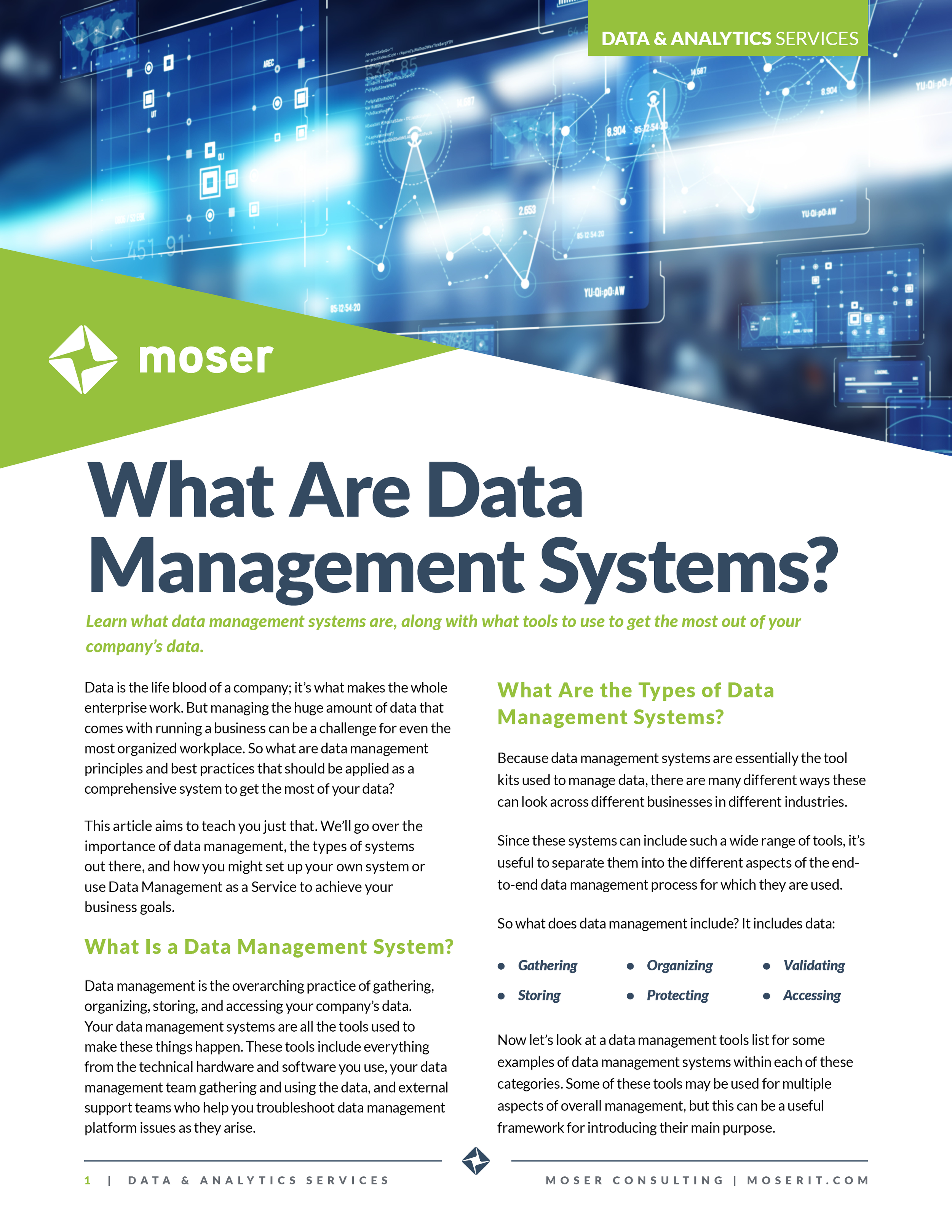
MOSER DEEP DIVE TECH CONTENT:
What Are Data Management Systems?
Larry Bird said: “First, master the Fundamentals”. Does your company have good data management foundations?
So what are data management principles and best practices that should be applied as a comprehensive system to get the most of your data?
Data is the life blood of a company; it’s what makes the whole enterprise work. But managing the huge amount of data that comes with running a business can be a challenge for even the most organized workplace. So what are data management principles and best practices that should be applied as a comprehensive system to get the most of your data?
This article aims to teach you just that. We’ll go over the importance of data management, the types of systems out there, and how you might set up your own system or use Data Management as a Service (DMaaS) to achieve your business goals.
What Is a Data Management System?
Data management is the overarching practice of gathering, organizing, storing, and accessing your company’s data. Your data management systems are all the tools used to make these things happen. These tools include everything from the technical hardware and software you use, your data management team gathering and using the data, and external support teams who help you troubleshoot data management platform issues as they arise.
What Are the Types of Data Management Systems?
Because data management systems are essentially the tool kits used to manage data, there are many different ways these can look across different businesses in different industries. Since these systems can include such a wide range of tools, it’s useful to separate them into the different aspects of the end-to-end data management process for which they are used.
So what does data management include? It includes data:
Gathering
Organizing
Validating
Storing
Protecting
Accessing
Now let’s look at a data management tools list for some examples of data management systems within each of these categories. Some of these tools may be used for multiple aspects of overall management, but this can be a useful framework for introducing their main purpose.
Data Gathering
Collecting data is the first step in any data management system, because without any data, none of the rest of the systems have anything to work with. Data gathering systems are wide ranging, and can include things like:
Inventory management tools
Customer satisfaction survey tools
Email signup forms
Manual data entry platforms
Data Organizing
Sorting and categorizing information as it comes in is the job of the next set of systems. If incoming facts and figures are just left as disparate files in a system, they are of little use since they can’t be easily discovered or accessed by the people who need them. In the past, a filing cabinet with a folder for each client may have worked as a convenient way of organizing business data, but most modern companies need something with more bells and whistles. This includes things like:
Spreadsheets
Databases
Big data management systems
Data Validating
Making sure that the data that’s been collected and organized is correct and categorized accurately is another important part of overall data management. There are a variety of validation checks that can be done on a dataset to ensure accuracy, including:
Data Type Checks - to ensure each field contains the correct form of data, makes sure things like phone numbers don’t contain letters
Range Checks - to check that fields that should be within a certain number range stay within it, makes sure a survey response column that should be between 1 and 10 falls within this range
Consistency Checks - to look for logic mistakes, makes sure a customer’s birth date isn’t listed as in the future
Data Storing
Having all your data collected, organized and validated, the next step in your data management system is deciding where to keep this information. Since data is the lifeblood of a company, it needs to be housed somewhere that it can be safe, backed up, and accessible. There are many different options for where to store business data that meets these requirements, like:
Cloud storage
In-house servers
Hybrid solutions
Data Protecting
Keeping the data you’ve spent so much time and resources on safe is (or should be) a top priority for businesses. Because data is susceptible to corruption, loss, theft, and various forms of cyber attack, it often requires multiple systems of protection. These can include:
Local and cloud backup
Encryption
Selective permission for access
Data Accessing
Using the data to carry out day-to-day business tasks, and to shape long range company plans, is the entire point of having this information to begin with. This makes being able to access, analyze, and act on data of utmost importance. Some of the myriad of tools that will carry out these functions are:
Marketing Automation Tools - Uses customer contact data, along with behavioral targeting and lead generation information to aid successful marketing efforts.
Customer Relationship Management (CRM) Tools - Empowers sales and CS teams to best serve customers by summarizing customer details like purchases, feedback, and contact information.
Return on Investment Tracking Tools - Allows companies to monitor the effectiveness of marketing strategies and profitability of different lead generation efforts.
What Are Key Elements of a Data Management System?
Since systems for managing data play such an important role in business, it’s important to consider what key elements are needed to make these systems as effective as possible. Some of the most important aspects you should look for are:
Integration
Facts and figures will come into a business from a range of different sources, and they need to be verified, stored, and accessed by a variety of tools. Overall, the system you use needs to be able to integrate with your existing tech stack.
Compliance
Rules and regulations around data storing and protection are common in many industries. Your business's data management system needs to ensure you follow the rules, and you need to be able to prove it when asked or audited.
Viewability
Data can only be useful if you can see and understand it, so ideally your system will include one source of truth where you can view all relevant details without needing to switch between many platforms.
Ease of Use
Team members and customers alike need to be able to use relevant parts of the data management system without difficulty, otherwise you risk them not using it at all. It should be fast and convenient to enter, edit, search, and find the information they need.
Real-time Experience
Inputs coming into the system should be able to be monitored as they happen. This lets a business find errors or problems as they are happening, making them easier to correct quickly.
Moser: We Can Help Show You How to Improve Data Management Skills
Data management systems can be a challenge to get right. There are a lot of moving parts to consider, but the end result of a good system is worth the effort.
Moser Consulting has been at the forefront of helping our clients get the most out of their technology for over 25 years. We work to become trusted, long-term partners serving your business goals, including data management.
Data Management as a Service (DMaaS) is a great option for getting the technical support you need to navigate this complex landscape. Moser can help, whether you need us to design a system from scratch for you, or just help you make your current system work better!
Get in touch today to see data management system examples and learn more about how we can help.
WATCH FOR THE NEXT ARTICLE IN THIS SERIES:
Since data is becoming increasingly complex and is generated at a higher volume than in the past, data management has become one of the most crucial components of how an organization operates.
According to Statista, the worldwide data management and analytics industry will be worth $274.3 billion by the end of 2022. Furthermore, around $85 billion is expected to be made up of IT services. Many companies across the globe have adopted the data-first corporate approach where data is a strategic asset. It is vital for corporate executives and operators to implement a well-structured data management strategy.




